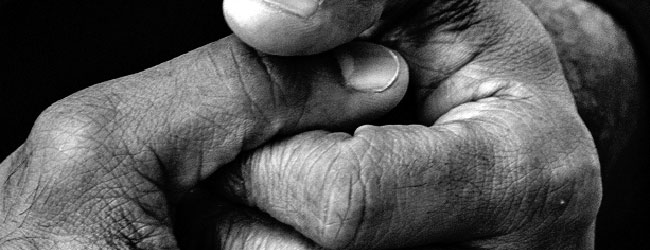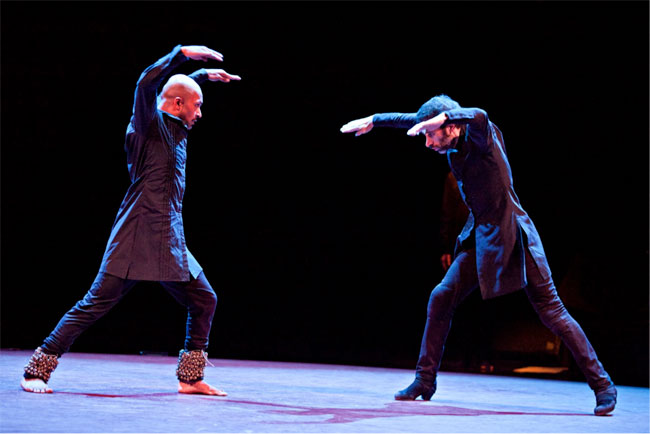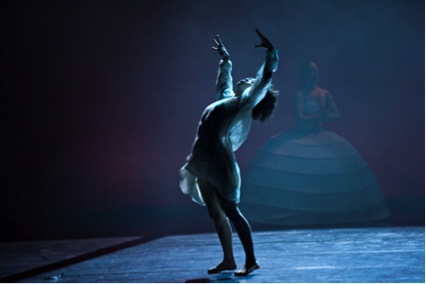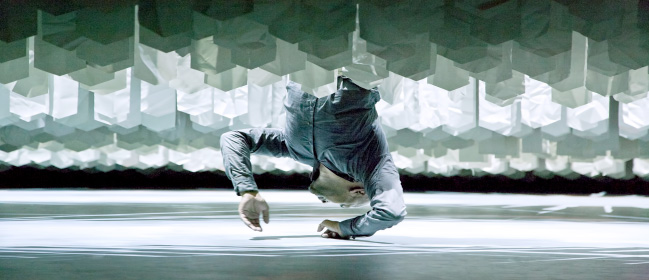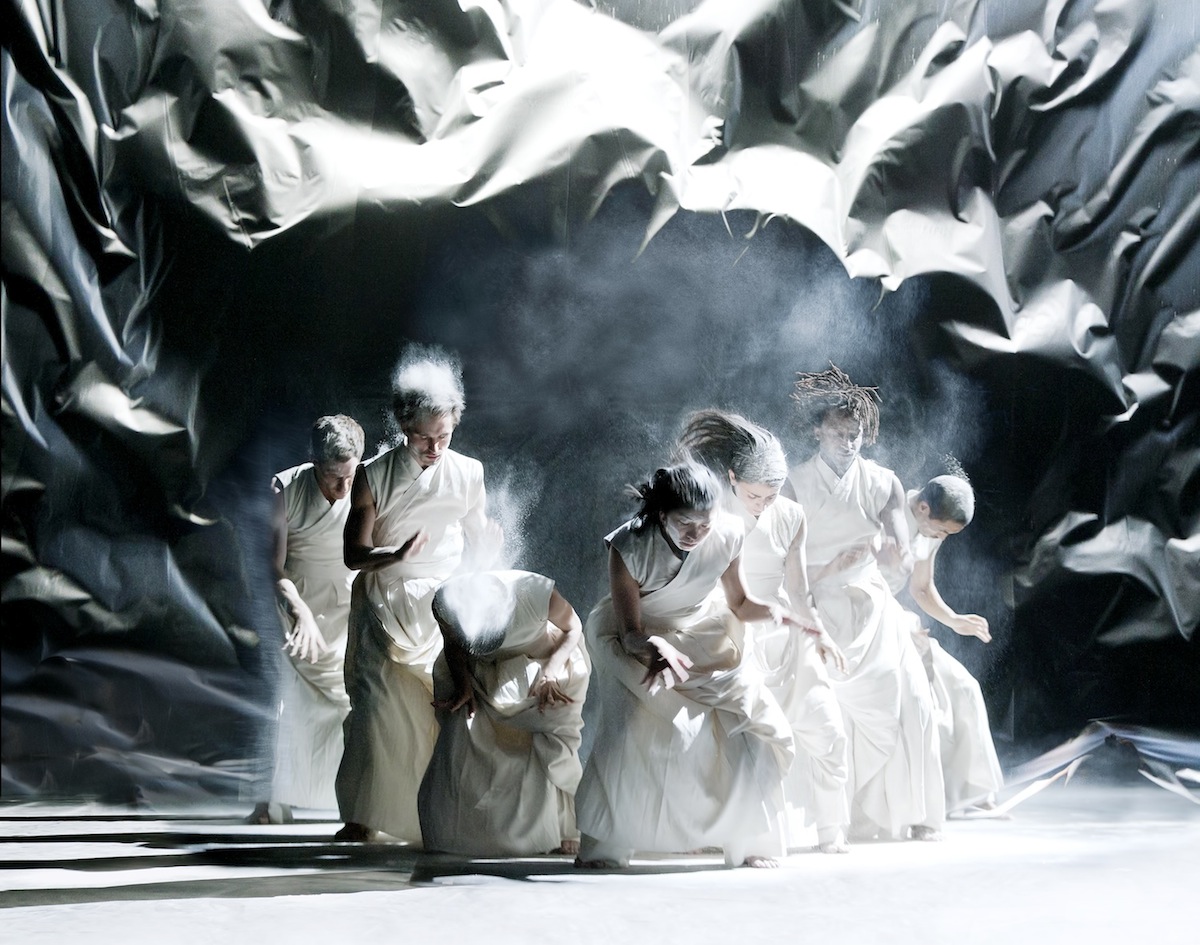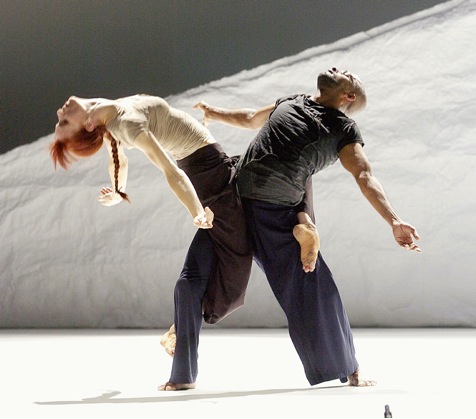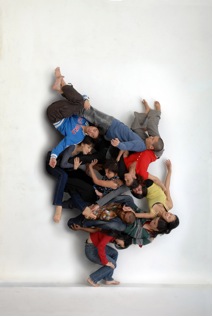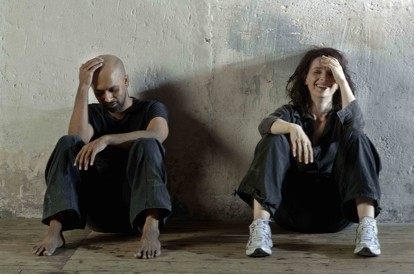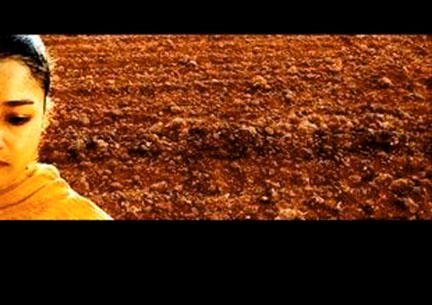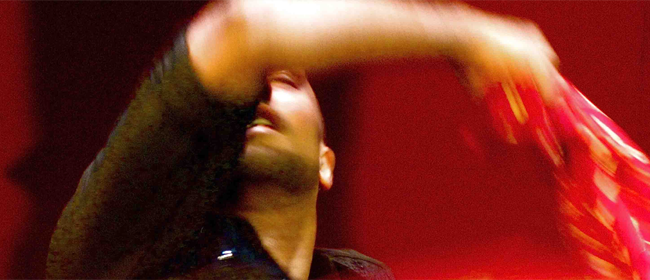World Première Stuttgart, 13 July 2019
AKRAM KHAN COMPANY
“As I arrive at the end of my dancing career, I have awakened to a new way of dancing. And that is to dance my ideas through the bodies of others, including older dancers, who carry their histories and complex emotional experiences within them. But what remains unchanged is my passion for exploring old and new myths in the context of our times.”
One of the seeds of inspiration for Outwitting the Devil is Leonardo Da Vinci’s iconic mural of The Last Supper. Thisimage has haunted me since I rst laid eyes on it as a child.
As a young British Bangladeshi boy growing up in South London, I remember seeing The Last Supper on a printed A4 page in my art class. I was told it was one of the most famous paintings in the world, and was asked to draw my own version of it. I now realise that at the time I was uncomfortable and confused by the depiction. I could not see anything of myself in it, or of the culture and religion I grew up in. It was foreign to me. Or perhaps, I was foreignto it. It did not re ect me, or the people in my street – who came from many different cultures – in any way I couldrelate to.
Many years later, I stumbled across another version of The Last Supper, by Australian artist Susan Dorothea White. White’s work was titled The First Supper. The painting portrays 13 women from all regions of the world. The gurein the position of Leonardo’s Christ is an Aboriginal woman, and the only white woman in the painting sits in the same position as Judas, the betrayer.
This radical interpretation astonished me, and gave me permission to free myself from the classical version. And in this new, anti-colonial depiction, I recognised an artist’s journey and challenge to convention which was parallel to my own. Ever since I entered the classical Indian dance world, I have been searching for a way out.... or perhaps more truly, I was searching for a new way in.
– Akram Khan, August 2018
Artistic team & credits
Artistic Director/Choreographer Akram Khan
Dramaturg Ruth Little
Lighting Designer Aideen Malone
Visual Designer Tom Scutt
Original Music Score and Sound Design Vincenzo LamagnaCostume Designer Kimie Nakano
Writer Jordan Tannahill
Rehearsal Director Mavin Khoo
Dancers Ching-Ying Chien, Andrew Pan, Dominique Petit, James Pham, Mythili Prakash, Sam Pratt
Producer Farooq Chaudhry
Technical Manager Tina FaganProduction Manager Florian StaglianoProject/Tour Manager Mashitah Omar
Supported by Arts Council England
Akram Khan is an Associate Artist of Sadler’s Wells London and Curve Leicester.
Technical Requirements
Playing Area 12m x 12m
Trim Height 8m
Dimmers
120 minimum
NO RAKE
Akram Khan
Artistic Director/Choreographer
Akram Khan is one of the most celebrated and respected dance artists today. In just over 18 years he has createda body of work that has contributed signi cantly to the arts in the UK and abroad. His reputation has been built onthe success of imaginative, highly accessible and relevant productions such as Until the Lions, Kaash, iTMOi (in the mind of igor), DESH, Vertical Road, Gnosis and zero degrees.
An instinctive and natural collaborator, Khan has been a magnet to world-class artists from other cultures anddisciplines. His previous collaborators include the National Ballet of China, actress Juliette Binoche, ballerinaSylvie Guillem, choreographers/dancers Sidi Larbi Cherkaoui and Israel Galván, singer Kylie Minogue, visual artistsAnish Kapoor, Antony Gormley and Tim Yip, writer Hanif Kureishi and composers Steve Reich, Nitin Sawhney,Jocelyn Pook and Ben Frost.
Khan’s work is recognised as being profoundly moving, in which his intelligently crafted storytelling is effortlessly intimate and epic. Described by the Financial Times as an artist “who speaks tremendously of tremendous things”, a highlight of his career was the creation of a section of the London 2012 Olympic Games Opening Ceremony that was received with unanimous acclaim.
As a choreographer, Khan has developed a close collaboration with English National Ballet and its Artistic DirectorTamara Rojo. He created the short piece Dust, part of the Lest We Forget programme, which led to an invitation to create his own critically acclaimed version of the iconic romantic ballet Giselle.
Khan has been the recipient of numerous awards throughout his career including the Laurence Olivier Award, the Bessie Award (New York Dance and Performance Award), the prestigious ISPA (International Society for thePerforming Arts) Distinguished Artist Award, the Fred and Adele Astaire Award, the Herald Archangel Award atthe Edinburgh International Festival, the South Bank Sky Arts Award and six Critics’ Circle National Dance Awards.Khan was awarded an MBE for services to dance in 2005. He is also an Honorary Graduate of University of London as well as Roehampton and De Montfort Universities, and an Honorary Fellow of Trinity Laban.
Khan is an Associate Artist of Sadler’s Wells, London and Curve, Leicester.
Ruth Little
Dramaturg
Ruth Little is a dance and theatre dramaturg, a teacher and writer. Her work has encompassed national arts organisations, remote rural communities, site-speci c production and large and small-scale exhibitions and expeditions. She lectured in English Literature at the University of Sydney, and was Literary Manager at Out ofJoint, Soho Theatre, the Young Vic and the Royal Court. Ruth was Associate Director at Cape Farewell from 2010- 2016. She is dramaturg with Akram Khan Company (Gnosis, Vertical Road, DESH, iTMOi, Dust, technê, Until the Lions, Giselle) and has worked with Banff Arts Centre, Sadler’s Wells, Barbican, and many others. Winner of 2012 Kenneth Tynan Award for dramaturgy, Ruth has a number of publications including Art, Place, Climate: Situated Ethics, War in the Body, and The Meteorological Body.
Aideen Malone
Lighting Designer
Aideen studied Drama and Theatre at Trinity College Dublin and Goldsmiths College, University of London. She works on a rich variety of projects in theatre, dance, opera, site speci c and installation. She has previously workedwith Akram Khan on Polaroid Feet and Kaash in 2002. In theatre, she has collaborated with National Theatre, BristolOld Vic, Lyric Hammersmith, Manchester Theatre Royal, Clod Ensemble, Young Vic, amongst many others. Aideenalso enjoys working with young people in education, and is currently a tutor at ALRA and St Marys, Twickenham. She is a director of Junction designing lighting sculptures and installations.
Tom Scutt
Visual Designer
Tom is a London-based Designer for the stage and live events. A graduate from the Royal Welsh College of Music and Drama in 2006, he regularly works at most of London’s major theatres including The National Theatre, The Royal Court, Almeida and Donmar Warehouse. On Broadway, Tom has provided set & costume designs forConstellations, King Charles III and Les Liaisons Dangereuses. His work reaches across live music (Sam Smith/ Apple, MTV VMAs), dance (Hofesh Shechter - Grand Finale) and exhibition design (Frida Kahlo: Making Her Self Up at London’s V&A Museum). Tom is an Honorary Fellow of the Royal Welsh College of Music and Drama, an Associate Artist of the Donmar Warehouse and a resident at Somerset House Studios.
Vincenzo Lamagna
Composer
Vincenzo Lamagna is a musician, composer and producer based in London. His music is known for its visceral,emotive and edgy language that utilises an unconventional hybrid of electro-orchestral sounds. Vincenzo has carved a niche in the alternative contemporary dance world, where he has established himself as a major collaboratorwith some of the most acclaimed choreographers of this generation, Hofesh Shechter and Akram Khan. His mostrecent collaborations include Until the Lions and Akram Khan’s award winning 21st-century adaptation of Gisellefor English National Ballet. His scores are a mercurial combination of acoustic and electronic music, recognisedfor their ferocious industrial undertones, haunted melodies and cinematic soundscapes.
Kimie Nakano
Costume Designer
Kimie Nakano has designed costumes for Northern Ballet, Lithuanian National Opera and Ballet, Royal DanishBallet, Companhia National de Bailado, English National Ballet, Van Huynh Company, The Royal Ballet of Flanders,Rambert Dance Company, David Nixon, Didy Veldman, Sidi Larbi Cherkaoui, José Agudo and Yabin Studio. Kimie’s opera production credits include: The Return of Ulysses by John Fulljames for Royal Opera and Tristan und Isoldeby Carmen Jakobi for Longborough Festival Opera. Her designs for Akram Khan Company include: Vertical Road,Dust (English National Ballet’s Lest We Forget), iTMOi, TOROBAKA, Gnosis, Kaash, The Rashomon Effect (National Youth Dance Company), technê (choreographed for Sylvie Guillem, Life in Progress).
Jordan Tannahill
Writer
Jordan Tannahill has been ‘widely celebrated as one of Canada’s most accomplished young playwrights, lm-makers and all-round multidisciplinary artists’ (Toronto Star). His plays have been produced on major stages internationally and translated into eight languages, while his lms and multimedia performances have beenpresented at festivals including the Toronto Int. Film Festival, the Tribeca Film Festival, and the Venice Biennial. In 2017, his play Late Company transferred to London’s West End. Upcoming: his virtual reality performance Draw Me Close, produced by the National Theatre (UK) and the National Film Board of Canada, will open at the Young
Vic in January 2019.
Mavin Khoo
Rehearsal Director
Mavin Khoo is internationally recognised as a dance artist, teacher, choreographer and artist scholar. His initial training was in Malaysia. He then pursued his training in Bharatanatyam intensively under the legendary dancemaestro Padma Shri Adyar K.Lakshman in India. As a contemporary dance artist, he has worked with WayneMcGregor, Akram Khan, Shobana Jeyasingh and many others. Khoo founded mavinkhooDance in 2003. He was Artistic Director of Ż nMalta Dance Ensemble between 2014 - 2017. He currently maintains his touring work as a mature artist with a focus on solo Bharatanatyam performances and speci cally commissioned contemporary duet works. He also worked as rehearsal director for Akram Khan Company production iTMOi and worked alongside Akram on Giselle (English National Ballet).
Ching-Ying Chien
Dancer
Ching-Ying Chien was born in Taiwan and graduated from the National Taiwan University of Arts. As well ascollaborating and creating work with a number of Taiwanese choreographers including Fang-Yi Sheu, Ching-Ying also worked as a physical model for Chinese artist Cai Guo-Qiang for his large-scale gunpowder on paper pieceDay and Night. She has worked with Akram Khan Company since 2013 and achieved the ‘Outstanding FemalePerformance (Modern)’ award at the UK National Dance Awards in 2016. In addition to performing on stage,Ching-Ying worked with director Adam Smith to shoot music videos for the likes of Plan B and The Chemical Brothers earlier this year. Most recently she has presented her solo Vulture in London and Taiwan.
Andrew Pan
Dancer
Andrew was born in Kuala Lumpur, Malaysia. Studying at the Federal Academy of Ballet in Malaysia, he was offered a scholarship to study at the Central School of Ballet in London. During his second year at Central, Andrew guested at Dublin City Ballet, in Giselle dancing the part of ‘Peasant Pas De Deux’. After touring with Notre Dame de Parisfor 3 years, he spent 5 years in the Celine Dion’s show A New Day in Las Vegas. Throughout his career Andrew hasworked with different choreographers and directors, including: Jiri Kylian, Rui Horta, Itzik Galili, Richard Wherlock,Roberto Galvan, Mia Michaels, Karl Schreiner, Christian Spuck, Carlus Pardrissa, Johann Kresnik, Jean Renshaw, Philipp Stölzl.
Dominique Petit
Dancer
Dominique Petit’s career started in New York with Paul Sanasardo. Returning to France to join the Paris OperaTheater Research Group under the direction of Carolyn Carlson for four years, he went on to present his rst solo at Avignon Festival. His choreographic pieces have toured to major dance festivals in Europe, Asia and South America, including his most proli c works, Jade and Les tournesols. Before teaching full-time in the Conservatory of La Roche sur Yon, he spent seven years as a pedagogical coordinator of the CNDC of Angers. Dominique has developed an innovative improvisation technique and is regularly invited to facilitate masterclasses in major French institutions.
James Pham
Dancer
James has been working extensively with Chunky Move - Anouk Van Dijk since 2012. Beside his collaborations with Eastman, Royal Ballet of Flanders, GöteborgsOperans Danskompani, Bayerische Staatsoper and Theater Basel, he has performed in Triumphs and Other Alternatives with Muscle Mouth and World of Wearable Art (2015).He was the lead role in Christophe Coppens’ Le Mandarin Merveilleux at La Monnaie. James received the ‘BestMale Dancer in a Dance or Physical Theatre Work’ 2014 Helpmann Award for his performance in 247 Days, and the Outstanding Performance by a Male Dancer 2014 Australian Dance Award for AORTA. He has been studying Countertechnique intensively since 2012, and became a certi ed teacher in 2014.
Mythili Prakash
Dancer
Classically trained in the Indian dance form Bharatanatyam, Mythili Prakash was born in Los Angeles and grew up training with her mother/dancer Viji Prakash. Performing her solo debut at just eight years old, she has since presented her work world-wide. Mythili’s full length solos include: Stree Katha, Yamuna, Seasons of Love,Chandalika, AIKYA - through the voice of Akka Mahadevi and JWALA-Rising Flame. In 2009, she collaborated with musician Anoushka Shankar in Svatantrya, with writer/director Gowri Ramnarayan in Yashodhara in 2012 and her brother/musician Aditya Prakash in MARA in 2013. Mythili worked with Director Ang Lee in the lm Life of Pi and was featured on NBC’s Superstars of Dance.
Sam Pratt
Dancer
Sam Asa Pratt was born and raised in New York City and graduated from Bard College with degrees in Dance and Philosophy. Sam has performed with Kate Weare Company, David Dorfman Dance, Abraham in Motion,The Francesca Harper Project, and for the past two years has been a full-time company member in Punchdrunk’sNew York production of Sleep No More. Sam is co-founder/director of movement art company Baye & Asa (@bayeandasa) presenting live performance and lm work in NYC.

